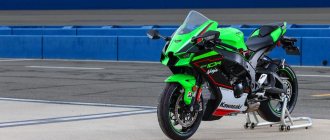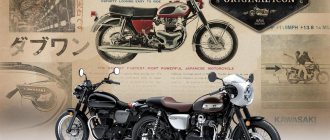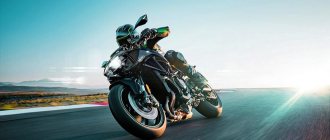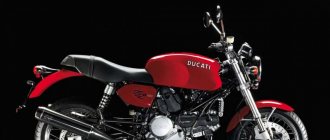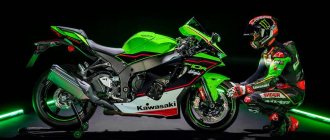| Kawasaki W800 (2011-2017) | Kawasaki W800 Cafe (2012-2017) | Kawasaki W800 Street (2019-2020) | Kawasaki W800 Cafe (2019-2020) |
| Kawasaki W800 (2021+) | Kawasaki W800 Street (2021+) | Kawasaki W800 Cafe (2021+) | Kawasaki W800 Meguro K3 (2021+) |
Model of a retro classic motorcycle Kawasaki W800
replaced the Kawasaki W650 model in 2011 and differed from it in a larger engine, fuel injection and the absence of a kick starter. The update of the Kawasaki W650 motorcycle was necessary due to the introduction of new environmental emission standards, which this model did not meet. In general, the Kawasaki W800 and Kawasaki W650 are practically no different from each other.
Main modifications of the Kawasaki W800:
- Kawasaki W800 Special Edition
is a special black version of the motorcycle. - Kawasaki W800 Cafe Style
- the regular and special versions of the motorcycle can be ordered in a cafe racer style with a front fairing. - Kawasaki W800 Final Edition
is the last modification of the W800 model before being discontinued. It features an orange tank color, a gold emblem and some other visual elements. Available from July 2016.
A special feature of the Kawasaki W800 is its in-line 2-cylinder air-cooled engine with a capacity of 773 cc. see, producing 48 hp. power and 60 Nm of torque. Unlike its predecessor (Kawasaki W650), the engine produces approximately the same characteristics in numbers, but has become noticeably more torquey, with lower maximum and operating speeds.
In 2016, Kawasaki announced the end of production and sales of the W800 model in the European market due to the release of new Euro 4 environmental standards, releasing a Final Edition modification, available from the summer of 2016.
In 2022, Kawasaki resumes production of the W800, offering 2 modifications:
- Kawasaki W800 Street
- Kawasaki W800 Cafe
Compared to the previous generation, the new one has a number of differences:
- Engine
. New settings. - Pendant
. The diameter of the fork stays increases from 39 to 41 mm. - Brakes
. The diameter of the front brake disc increases from 300 to 320 mm, the rear drum is replaced by a disc brake (270 mm disc, 2-piston caliper). The motorcycle comes with ABS as standard. - Wheels
. The front wheel is now 18 inches (instead of 19), thereby equalizing the size of the front and rear wheels. - Fuel tank
. Increase in capacity from 14 to 15 liters.
In 2022, Kawasaki introduced the new generation W800. The classic version of the W800 has been updated, receiving components from the more recent Street and Cafe modifications. In particular, the braking system (320 mm front disc, 270 mm disc instead of the rear drum, ABS system), suspension and fuel tank. The updated Street and Cafe versions have received a new color scheme. Japanese versions of motorcycles declared a power of 52 hp. (versus 48 hp in previous export versions). In addition, a new modification was offered exclusively for the Japanese market - Meguro K3
. It is built on the basis of the regular version of the W800, but with a higher handlebar and the exclusive Japanese retro style of Meguro motorcycles produced since the 30s of the last century. It is noteworthy that Kawasaki has patented the Meguro brand for its future models, and the Meguro K3 version itself is positioned by the company as a separate model, and not a modification as part of the W800.
By 2022, the Kawasaki W800 has largely disappeared from foreign markets (with the exception of the base W800 version, which is still produced and sold for North America), remaining available only in Japan.
Brief history of the model
- 2011 - start of production and sales of Kawasaki W800.
Model
: Kawasaki W800, Kawasaki W800 ABS (Japan, Europe).
Frame number
: EJ800A-000001-004232, EJ800A-004233-.
Factory designation
: EJ800ABF, EJ800ABS.
- 2012 - a Special Edition version is sold in parallel with the regular version. In addition, a Cafe Style option is available for both versions.
Model
: Kawasaki W800 (Japan, Europe).
Frame number
: EJ800A-008001-015000.
Factory designation
: EJ800ACF, EJ800ACFA, EJ800ACFB.
- 2013 - no significant changes.
Model
: Kawasaki W800 (Japan, Europe).
Frame number
: EJ800A-015001-.
Factory designation
: EJ800ADF, EJ800ADFA.
- 2014 - no significant changes.
Model
: Kawasaki W800 (Japan, Europe).
Frame number
: EJ800A-018001-.
Factory designation
: EJ800AEF, EJ800AEFA, EJ800AEFB.
- 2015 - no significant changes.
Model
: Kawasaki W800 (Japan, Europe).
Frame number
: EJ800A-023001-.
Factory designation
: EJ800AFF, EJ800AFFA, EJ800AFFB.
- 2016 is the last year of production and sales of the W800 model for the European market. The appearance of the Final Edition modification.
Model
: Kawasaki W800 (Japan, Europe).
Frame number
: EJ800A-026001-.
Factory designation
: EJ800AGF, EJ800AGFA, EJ800AGS.
- 2017 - Model available only in Japan.
Model
: Kawasaki W800 (Japan).
Factory designation
: EJ800AHF.
- 2019 - resumption of production of the model. The previous generation has been replaced by two modifications - Street and Cafe.
Model
: Kawasaki W800 Street;
Kawasaki W800 Cafe (Japan, Europe, North America). Factory designation
: EJ800BKF; EJ800CKF.
- 2020 - no significant changes.
Model
: Kawasaki W800 Street;
Kawasaki W800 Cafe (Japan, Europe, North America). Factory designation
: EJ800BLF; EJ800CLF.
- 2021 - restyling of the model. The emergence of a new modification of Meguro K3.
Model
: Kawasaki W800;
Kawasaki W800 Street; Kawasaki W800 Cafe; Kawasaki W800 Meguro K3 (Japan, Europe, North America, Australia). Factory designation
: EJ800DMFNL (W800, North America); EJ800BMFNN (W800 Street, Australia); EJ800CMFNN (W800 Cafe).
- 2022 - only the basic version of the W800 is available in the North American export market, while in Japan the model is available in all modifications.
Model
: Kawasaki W800;
Kawasaki W800 Street; Kawasaki W800 Cafe; Kawasaki W800 Meguro K3 (Japan, North America). Factory designation
: EJ800DNFNL / EJ800DNFNN (W800, North America).
Kawasaki W800
W800 is the “successor” of the Kawasaki W650. This is a retro classic with British design, a slightly larger engine and new fuel injection. In addition, the kick starter was removed. Their main difference is in environmental friendliness; the “eight hundred” fully fits into modern emission standards, which cannot be said about the “650”. As a result, this model became the first worthwhile answer to the Japanese Triumph Bonneville T100.
Content
Main technical characteristics
Maximum speed: 175km/h; Frame: steel tube; Engine: 4 strokes, 2 cylinders, in-line; Volume: 773 “cubes”; Transmission: 5 speeds; Drive: chain; Power: 48 “horses”; Max.KM: 60Nm Cooling: air; Fuel supply: injector; Ignition: transistor; Suspension: front – telescopic fork, rear – pendulum, 2 shock absorbers (106mm travel); Brakes: front – disc (300mm), 2-piston caliper, rear – drum (160mm); Dimensions: 2190x790x1075mm (saddle – 790mm, base – 1465mm); Tank: 14 l (consumption 5.5 l/100 km); Weight (with equipment): 216 kg.
Peculiarities
The first thing that attracts attention is management. Steering the bike is very comfortable, which is facilitated by the wide handlebars, proportions, and classic vertical seating position. In addition, the motorcycle is stable and has a smooth ride. The brakes are also excellent, the front disc does its job fully, and in severe cases it is helped by the rear drum.
The main feature of the “eight hundred” is its engine. The operating figures are almost identical to those of the 650, but at the same time the engine is much more torquey and quieter, and has lower operating and maximum speeds. In other words, at medium and low speeds it will “pull” well even in high gears.
The design is also top-notch – a ribbed saddle, wheels with thick spokes, a lowered steering wheel, and exhaust trims. All parts are either chromed or lacquered, which, combined with the restrained color scheme and overall layout, creates the impression of a real British retro of the mid-20th century.
The instrument panel combines classic and modern: an analogue tachometer and speedometer are adjacent to an LCD screen displaying the tripmeter, clock and odometer. Also on the panel are “flashing lights” for turns and neutral, and an oil indicator.
Modifications
3 varieties of the “eight hundred” were produced:
- Cafe Style (2012). Variation of the “cafe racer” with a front fairing.
- Special Edition (2012). The same motorcycle in black design.
- Final Edition (2016). The latest update with purely visual differences: a gold emblem and an orange tank.
From 2022 The 800 is officially sold only in Japan.
Kawasaki W800 Vertical Twin
The four-stroke, two-cylinder Vertical Twin engine has an indescribable sound. The Kawasaki growls very quietly at low speeds, as if a tiger is preparing to jump.
An excellent city motorcycle that has a fairly powerful engine, an excellent 39 mm telescopic front fork, which will perfectly take on the unevenness of both asphalt and rough terrain, and you will feel as comfortable as possible on the motorcycle.
Probably the most attractive thing about it is its classic silhouette, the motorcycle is made in the style of classic retro models, a large number of chrome parts, an excellent large seat that allows you to ride with a passenger. The front of the bike has a truly traditional motorcycle look, from the round headlight to the instrument panel.
An excellent choice for lovers of style, comfort, and speed.
Specifications
Technical characteristics of Kawasaki W800:
| Model | Kawasaki W800 |
| Motorcycle type | retro classic |
| Year of issue | 2011+ |
| Frame | steel tubular |
| engine's type | 2-cylinder, 4-stroke, in-line |
| Working volume | 773 cm³ |
| Bore/Stroke | 77.0 x 83.0 mm |
| Compression ratio | 8.4:1 |
| Cooling | air |
| Number of valves per cylinder | SOHC, 4 valves |
| Fuel supply system | injector, 2x Keihin TTK34 |
| Ignition type | transistor |
| Maximum power | 48.0 hp (35 kW) at 6500 rpm 48.0 hp (35 kW) at 6000 rpm - W800 Street, W800 Cafe 52 hp (38 kW) at 6500 rpm - W800 (2021+, Japan) |
| Maximum torque | 60.0 Nm (6.1 kg*m) at 2500 rpm 62.9 Nm (6.4 kg*m) at 4800 rpm - W800 Street, W800 Cafe 62.0 Nm (6.4 kg*m) at 4800 rpm - W800 (2021+, Japan) |
| Clutch | Multi-disc in oil bath, cable drive |
| Transmission | 5-speed |
| type of drive | chain |
| Front tire size | 100/90-19 M/C 57H 100/90-18 M/C 56H – W800 Street, W800 Cafe |
| Rear tire size | 130/80-18 M/C 66H |
| Front brakes | 1 disc, 300 mm, 2-piston caliper 1 disc, 320 mm, 2-piston caliper (ABS) — W800 Street, W800 Cafe, W800 (2021+) |
| Rear brakes | drum, 160 mm 1 disc, 270 mm, 2-piston caliper (ABS) — W800 Street, W800 Cafe, W800 (2021+) |
| Front suspension | 39mm telescopic fork, 130mm travel 41mm telescopic fork, 130mm travel – W800 Street, W800 Cafe, W800 (2021+) |
| Rear suspension | pendulum with two shock absorbers (adjustable preload), stroke - 106 mm |
| Motorcycle length | 2190 mm - W800, Meguro K3 2135 mm - W800 Street, W800 Cafe |
| Motorcycle width | 790 mm - W800 925 mm - W800 Street, Meguro K3 825 mm - W800 Cafe |
| Motorcycle height | 1075 mm 1120 mm - W800 Street 1135 mm - W800 Cafe 1130 mm - Meguro K3 |
| Wheelbase | 1465 mm |
| Minimum ground clearance (clearance) | 125 mm - W800, Meguro K3 130 mm - W800 Street, W800 Cafe |
| Seat height | 790 mm - W800, Meguro K3 770 mm - W800 Street |
| Acceleration 0-100 km/h (0-60 mph) | 5.1 sec[1] |
| Maximum speed | 177 km/h[2] |
| Gas tank capacity | 14.0 l 15.0 l — W800 Street, W800 Cafe, W800 (2021+) |
| Motorcycle weight (curb) | 216 kg 221 kg - W800 Street 223 kg – W800 Cafe 226 kg - W800 (2021+) 227 kg - Meguro K3 |
002_MOTO_1210_044
A “real” Kawasaki W1 from 1965.
A “real” Kawasaki W1 from 1965.
But in this damned world, even retro technology must be improved all the time so as not to fall out of favor. So the arrival of the W800 was inevitable. What's new in the old? Increase in working volume by 97 cm³, reduction in maximum power by 2 hp. (but at the same time peak torque has shifted from 6000 to 2500 rpm), fuel injection instead of carburetors and some stylistic touches. The concept of the car remained unchanged: a parallel “twin” with an overhead camshaft drive by a vertical shaft and bevel gears, a steel duplex frame (with a rectangular cross-section), a classic type of suspension, and spoked wheels.
But even with such a modest update, the W800 became one of the most anticipated premieres of the season. Classic forever!
Reviews
Reviews about Kawasaki W800:
Expand Collapse
Greetings to all. I want to share my impressions of this motorcycle, which I became the owner of this year. This is not my first motorcycle and my impressions of it are therefore quite conscious and balanced. I myself am a fan of classic motorcycles. Before making my choice, I looked closely at potential candidates for quite a long time and these included Triumphs (Bonnevilles) and Kawasakis (W650) and the very exotic Motoguzzi…. What held me back in the acquisition, and of course, first of all, money.... well, God bless them... One way or another, it coincided that at the end of last season information appeared about a “new” model in the Kawasaki line - the Kawasaki W800 retrobike. Well, then I fell for him... When I got acquainted with the technical data for it and completely realized that it was mine... In March I purchased this motorcycle from the office. Kawasaki dealer in St. Petersburg and I assume that I am probably perhaps the first owner of this model in Russia. Motorcycles (like the entire class of these motorcycles), of course, are not for everyone... in the good sense of the word, and therefore, they will not be particularly popular in our country (which, of course, does not bother me at all). The appearance is simply superb. Everything is done with super high quality and soundness. Only metal and high-quality chrome. If you compare it with Triumph, then perhaps it will even surpass it in this sense (my opinion). :blush2: The engine is just super! Injection of course adds a completely new quality to this motorcycle (the previous model was carb). Excellent peak torque already at 2000-2300 rpm. min., which makes for very comfortable movement in a reasonable speed range (up to 120) and at lower speeds it’s just a delight. Potentially capable of ventilating the brain (maximum speed is about 180, although, of course, it is not 100% for this). Minimum vibrations and quite pleasant sound. The brakes are sufficient for a calm, balanced driving style (although, of course, there are never too many of them). Good light (solidly good). Good place for a passenger and footrests for him. In general, the motorcycle can be described as a very well made (I mean all components), comfortable motorcycle for long-distance trips and for daily trips. From a technical point of view, no exotics, only time-tested solutions in high-quality implementation from excellent materials. So far only positive impressions, and then we’ll see...
Almost a year and a half later…….
I will express a certain idea that is IMPORTANT in my opinion, which (I think) will be useful for those who are considering purchasing this model.
When thinking about buying this moto, you should clearly understand and imagine that any dynamic (by modern standards) riding will be impossible in principle, even for a short time.....Bonneville (for example), in this sense, is significantly preferable. We can only talk about style, ease of control and comfort (taking into account the class of the model and at speeds up to 100). In this situation, Bonneville is not so convincing.
This motorcycle is simply damn beautiful, attractive, and considering it from the point of view of modern technologies and modern technical solutions is completely unacceptable. In fact, it itself (and its technical characteristics) is a reflection of the middle of the last century, only in a modern incarnation and this is its whole essence.....And THIS is exactly what you need to understand and you need to be prepared for THIS, especially if this is not your first spendthrift. Otherwise disappointment is inevitable!!!
It’s easier for beginners (without motorcycle driving experience), for them everything is all over again and for the first time, although especially “gifted” motorcyclists may quickly get bored with it and begin to think about changing.....or frankly regret the purchase.
begin to think about changing.....or frankly regret the purchase.
000_MOTO_1210_044
Kawasaki W800: neoclassic, 2011, 773 cm³, 48 hp, 216 kg.
Kawasaki W800: neoclassic, 2011, 773 cm³, 48 hp, 216 kg.
Japanese concerns love to remind of their past achievements by presenting something tasty in a retro style. But Kawasaki is a champion in this matter. Let us at least remember the Zephyr series, which was super successful in the 80s and 90s, and the cute and nostalgic baby Estrella. And 12 years ago, the company showed the world almost a British classic of the 50s in all its glory: the W650. When viewed from afar, only the front disc brake revealed the true age of the car!
WHERE DOES THE BOY GET THE BRITISH SADNESS? Back in 1937, when zaibatsu (financial and industrial empires characteristic of the economy of pre-war Japan. Ed.) Kawasaki did not even think about motorcycles, the Meguro Seisakusho company released a copy of the English Velocette - model Z97. She was actively copying the British after the war, reaching in 1955 the release of the two-cylinder Senior - an adaptation of the 650 cc BSA. During the total “cleansing” of the Japanese motorcycle industry at the turn of the 50s and 60s, Meguro found itself in the clutches of Kawasaki. So Senior turned into W1, and its production continued right up until 1975! Of course, modern W650/W800 technically have nothing in common with this model. Suffice it to say that the W1 had a gas distribution mechanism, as befits the “British”, with a lower camshaft and overhead valves (OHV).
Motorcycle Kawasaki W 800 2022 review
Technical specifications Kawasaki W 800 2020
Engine Kawasaki W 800 2020
Transmission Kawasaki W 800 2020
Dimensions and weights of Kawasaki W 800 2020
Chassis and brakes Kawasaki W 800 2020
Dynamic characteristics of Kawasaki W 800 2020
Other characteristics of Kawasaki W 800 2020
Description Kawasaki W 800 2020
The description of the Kawasaki W 800 2022 motorcycle is in the queue for publication of the article. Announcement: Today, for almost every new motorcycle that comes into being, marketers strive to carve out their own niche. This one is a road sport, this one is a recreational enduro. But what class should we include a motorcycle that has a little bit of everything? A good bike should have a reliable engine, comfortable ergonomics and simple controls.
Despite the fact that good models of motorcycles have a very respectable price, and the season for their use is relatively short, the motorcycle market is developing rapidly. And if you believe the words of dealers, then some models of recently released motorcycles are selling like hot cakes at the beginning of the season, and the models brought to Russia are clearly not enough to fully satisfy consumer demand.
A motorcycle has long ceased to be an alternative to a car, and the times when this equipment was bought only because there was not enough money for a full-fledged car are forgotten. Nowadays, two-wheelers can be called technological marvels in many cases, and their cost can be compared with that of prestigious cars.
Many people have started buying motorcycles for hobby purposes as riding or even collecting them has become a good pastime for many people. Many motorcycles, for example the Kawasaki W 800, whose technical characteristics make it possible to call the model a prestigious brand, are in demand among both beginners and experienced motorcyclists.
Motorcycles with an engine capacity of 773 cc / 47.1 cu-in. see, appeared as a result of long work of inventors who sought to create a model that was not inferior in characteristics to other versions of the motorcycle. In some cases, these models are not only not inferior, but also ahead of other motorcycles, as they have minimal fuel consumption and other excellent parameters.
Motorcycles with an engine capacity of more than 400 kb. cm, which includes the Kawasaki W 800 - this category of motorcycles simply cannot claim the title of “motorcycle for a beginner.” On the contrary, this is already a serious technique that requires certain control of motorcycle equipment with a smaller engine capacity. Yes, she attracts more attention, she is the most beautiful, fast, interesting and there is a huge selection of models. But as power increases, the weight of the motorcycle inevitably increases. In this class you are unlikely to find motorcycles lighter than 180 kg, unless they are the latest motorcycle models.
Go to the entire range of Kawasaki motorcycles, on this page you can find Kawasaki W 800 motorcycles from other years of production and information about them
Price of Kawasaki W 800 according to sales advertisements
* Attention! Under the maximum, average and minimum of the Kawasaki W 800 motorcycle on this page, the average cost according to advertisements for sale on the Internet is indicated, without taking into account the year of manufacture, configuration and generation of the motorcycle model.
Kawasaki W 800 sales statistics by regions of the Russian Federation (in the form of shares)
- St. Petersburg 11.07%
- Moscow 19.56%
- Krasnodar region 9.96%
- Rostov region 4.43%
- Sverdlovsk region. 4.43%
- Moscow region 4.06%
- Chelyabinsk region 4.80%
- Tatarstan 6.27%
- Nizhny Novgorod region. 4.06%
Five random motorcycles:
Five random articles about motorcycles:
Color diagram of electrical equipment CZ 350 472
Electrical equipment CZ 472 (Click on the picture to enlarge) 1— main headlight lamp (6 V, 35 + 35 W); 2— parking light lamp (6 V, 4 W); 3— direction indicator lamp (6 V, 15 W); 4 — turn signal indicator lamp (b V, 2 W); 5 - high beam warning lamp (6 V" 2 W); 6 — control lamp for turning on neutral gear (6 V, 2 W); 7 — lamp for monitoring generator operation (6 V, 2 W); 8 — speedometer lighting lamp (in V, 2 W); 9 - central switch; 10 — turn signal interrupter relay; 11 — turn signal switch; 12 — switch for low-high beam with a button for turning on the sound signal; 13 — sound signal; 14 and 16 — spark plugs; 15 — ignition coils; 17 — brake light switch; 18 — switch for the neutral transmission warning lamp; 19 — right cylinder breaker contact; 20 - capacitors.
Motorcycle IZH Jupiter 4. As tested
As during testing Last fall, we transported the new IZH-Jupiter-4 motorcycle with a sidecar from Tashkent to Perm. A distance of about 3,500 kilometers was covered in six days. Almost more than half of the journey was spent running in, so they tried not to exceed the speeds allowed by the factory, and the limiter was removed only after 3,000 kilometers. But it was beyond our power to provide the easy road conditions recommended by the instructions. True, the load on the motorcycle was small - only the driver (the second one was riding in the car), but the Central Asian heat, long climbs, rocky road, and at the end of the road the Siberian Highway washed out by rains demanded high reliability from the car. In general, Jupiter-4, to our joy and, admittedly, some surprise, passed the severe test that the trip essentially turned out to be with honor. Judge for yourself. The prediction of Tashkent motorcyclists about the inevitability of engine overheating finally dissipated at the pass between X.
Muffler repair. Ural M63 and similar.
About the repair of mufflers On M-63 Ural motorcycles, mufflers fail due to destruction (burnout) of the internal set. First, one muffler and one muffler fails, and then at high engine speeds the motorcycle shakes. I extended the life of the mufflers by replacing the internal set with a 20 hole pipe as shown in the picture. We weld the support disk 2 to the front pipe, the bushing 6 to the rear and adjust them so that the disc fits tightly in the exhaust pipe 1, and the bushing fits in the tapering part of the muffler. We drill a hole for screw 5 (or two bolts) after preparing and installing the pipe. Reworked muffler: 1 — exhaust pipe; 2 — support disk; 3 — muffler body: 4 — pipe insert: 5 — M5 screw. split washer and nut; 6— bushing. All parts are steel. Both mufflers need to be repaired at the same time so that their resistance is the same. For the same purpose, disks 2 should be processed together, connecting them with an M5.Remont screw.
Dnepr 12. Tests
A motorcycle for any road The Dnepr-12 can be ridden not only on dirt roads, but also where there are none. The drive of the stroller wheel is provided by a gearbox and a cardan shaft, which have a sufficient margin of safety and high reliability. Two years ago, the Kiev motorcycle plant pleased the village residents with the start of production of off-road motorcycles “Dnepr-12” (see “Behind the Wheel”, 1977, No. 11). The car acquired this new property thanks to two driving wheels - the rear wheel and the sidecar. It has a number of original components that require certain skills and knowledge for proper operation. In order to get to know the new motorcycle better and tell readers about it, last summer one of us (A. Sokolov, on whose behalf the first part of the test will be conducted) went to factory. The mileage of the car provided to us was only 4 kilometers. Thus, editorial tests began with a run-in, and a 1000-kilometer run.

